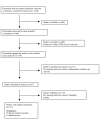Socioeconomic and racial/ethnic differentials of C-reactive protein levels: a systematic review of population-based studies
- PMID: 17705867
- PMCID: PMC2018719
- DOI: 10.1186/1471-2458-7-212
Socioeconomic and racial/ethnic differentials of C-reactive protein levels: a systematic review of population-based studies
Abstract
Background: Socioeconomic and racial/ethnic factors strongly influence cardiovascular disease outcomes and risk factors. C-reactive protein (CRP), a non-specific marker of inflammation, is associated with cardiovascular risk, and knowledge about its distribution in the population may help direct preventive efforts. A systematic review was undertaken to critically assess CRP levels according to socioeconomic and racial/ethnic factors.
Methods: Medline was searched through December 2006 for population-based studies examining CRP levels among adults with respect to indicators of socioeconomic position (SEP) and/or race/ethnicity. Bibliographies from located studies were scanned and 26 experts in the field were contacted for unpublished work.
Results: Thirty-two relevant articles were located. Cross-sectional (n = 20) and cohort studies (n = 11) were included, as was the control group of one trial. CRP levels were examined with respect to SEP and race/ethnicity in 25 and 15 analyses, respectively. Of 20 studies that were unadjusted or adjusted for demographic variables, 19 found inverse associations between CRP levels and SEP. Of 15 similar studies, 14 found differences between racial/ethnic groups such that whites had the lowest while blacks, Hispanics and South Asians had the highest CRP levels. Most studies also included adjustment for potential mediating variables in the causal chain between SEP or race/ethnicity and CRP. Most of these studies showed attenuated but still significant associations.
Conclusion: Increasing poverty and non-white race was associated with elevated CRP levels among adults. Most analyses in the literature are underestimating the true effects of racial/ethnic and socioeconomic factors due to adjustment for mediating factors.
Figures
References
-
- Lopez AD, Mathers CD, Ezzati M, Jamison DT, Murray CJL. Global Burden of Disease and Risk Factors. NY , Oxford University Press; 2006. - PubMed
-
- WHO WHO Global Strategy on Diet, Physical Activity and Health. Cardiovascular disease: prevention and control http://www.who.int/dietphysicalactivity/publications/facts/cvd/en/ - PubMed
-
- Cooper R, Cutler J, Desvigne-Nickens P, Fortmann SP, Friedman L, Havlik R, Hogelin G, Marler J, McGovern P, Morosco G, Mosca L, Pearson T, Stamler J, Stryer D, Thom T. Trends and Disparities in Coronary Heart Disease, Stroke, and Other Cardiovascular Diseases in the United States : Findings of the National Conference on Cardiovascular Disease Prevention. Circulation. 2000;102:3137–3147. - PubMed
-
- Cooper RS. Social inequality, ethnicity and cardiovascular disease. Int J Epidemiol. 2001;30:S48–52. - PubMed
-
- Dalstra JAA, Kunst AE, Borrell C, Breeze E, Cambois E, Costa G, Geurts JJM, Lahelma E, Van Oyen H, Rasmussen NK, Regidor E, Spadea T, Mackenbach JP. Socioeconomic differences in the prevalence of common chronic diseases: an overview of eight European countries. Int J Epidemiol. 2005;34:316–326. doi: 10.1093/ije/dyh386. - DOI - PubMed
Publication types
MeSH terms
Substances
LinkOut - more resources
Full Text Sources
Medical
Research Materials
Miscellaneous



